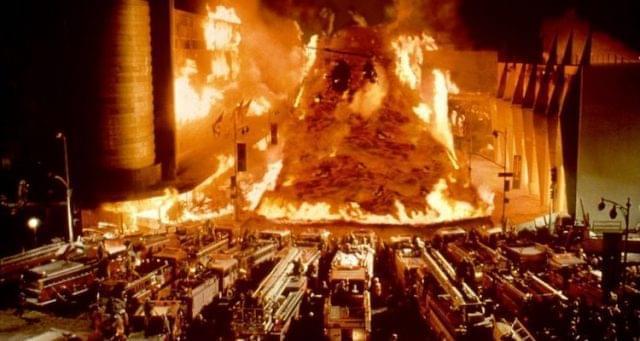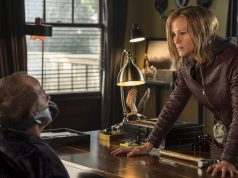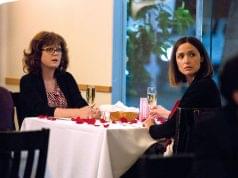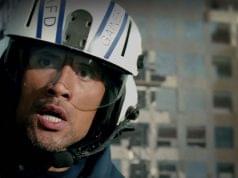
“Volcano” is a very famous movie because it happened to come out two months after “Dante’s Peak,” which was also about a volcano but which, lucky for the makers of “Volcano,” hadn’t used the word “volcano” in its title. A similar phenomenon happened the next year, when “Deep Impact” and “Armageddon” were released, both about giant space objects hurtling toward Earth. And it happened again in 2001, when you had the two films about grotesque swamp monsters, “Shrek” and “Bridget Jones’s Diary.”
“Volcano” begins with a title card informing us that in Los Angeles, the Office of Emergency Management has authority to take over everything in the event of a major catastrophe (earthquake, mudslide, loss of cell phone reception, etc.). This is to prepare viewers to accept it later on when an Office of Emergency Management bureaucrat shows up at the scene of a natural disaster and starts bossing police and firefighters around, since otherwise the viewers would scoff and throw things at the screen, especially since the cops and firemen don’t even ask the guy for credentials or a badge or anything. They just see he’s wearing an Office of Emergency Management jacket and immediately defer to him on all subjects, even though for all they know he’s just a really big Office of Emergency Management fan. I mean, anyone can go to the Office of Emergency Management gift shop and buy one of those jackets.
It probably helps that the Office of Emergency Management guy is played by Tommy Lee Jones, whose shar pei face and stern, solitary eyebrow make it clear that he is not a man to be trifled with or permitted near children. Jones’ character, Mike Roark, is called into action when an earthquake hits L.A. It’s just a li’l ol’ 4.9 on the Richter scale, barely enough to shake Californians out of their tanning beds, but Roark likes to be thorough. Frankly, I think he enjoys natural disasters.
Then there is a seismologist who shows up at Earthquake Headquarters (or whatever) to tell the news reporters what’s happening. She is Dr. Amy Barnes (Anne Heche), and she’s clearly L.A.’s most beloved seismologist. She works the crowd like a pro. Everyone from her nerdy colleagues to the assembled press corps is glad to see her. “Hey,” she says smoothly when she saunters into the room, flashing a huge grin. “You guys didn’t feel anything this morning, didja?” Oh, she’s a slick one, that Dr. Amy Barnes. She is the standard by which all other celebrity seismologists are measured.
Meanwhile, in standard Disaster Movie fashion, the film is introducing us to other characters in L.A., some of whom will later die horribly. One of them is a medical doctor, Jaye Calder (Jacqueline Kim), whose awful husband, Norman (John Corbett), is a rich jerk first seen protesting the opening of a new subway line. Yes, L.A. has a subway. The only time you ever hear about it — and this goes for actual residents of Los Angeles, too — is when it figures into the plot of a movie. The only way Southern Californians will ever use a subway in large numbers is if they can drive their cars onto it.
It’s not the wastefulness of a subway that Norman is protesting, though, nor is it the risk inherent in digging a network of large tunnels under a city so famous for being geologically unstable. No, he’s protesting because he’s about to open a ritzy new apartment building, and he’s afraid the new subway line will bring too many poor into that part of town. In other words, on the “Should L.A. Have a Subway?” test, Norman gets the right answers but loses points when he shows his work.
That small-ish earthquake doesn’t cause much damage above ground, but down in a sewer tunnel it dislodges a pocket of hot gas that cooks seven Water & Power Department employees. Basically, they were killed when the earth farted. This is what happens when the earth eats too much Indian food. The incident alarms Roark, who thinks something weird is happening and declares, “Find me a scientist!” For many years, this was the least interesting thing ever said in an action movie, until it was replaced by “I have to get to a library — fast!” in “The Da Vinci Code.”
Roark says they should shut down the subway until further notice. But the head subway guy, Stan (John Carroll Lynch), says it was ordinary steam that boiled those men, and that sort of thing has been known to happen, and the tunnels are perfectly safe, and Roark is overreacting and should butt out. Stan has dared to defy the mighty Office of Emergency Management! He will pay for his insolence! More specifically, he will melt like the Wicked Witch of the West in a pool of lava while throwing an injured man to safety.
But I am getting ahead of myself. Roark listens when celebrity seismologist Dr. Amy Barnes tells him that something strange is definitely happening, but he has a hard time believing her theory that a volcano is forming underneath Los Angeles. I mean, who ever heard of anything being created in L.A. without a pitch meeting? But there’s another earthquake early the next morning, a huge one this time, and it’s the result of volcanic activity under the city, probably the result of Satan trying to dig a shortcut between hell and Hollywood. This volcano shoots fire balls out of the La Brea Tar Pits, which is a fairly awesome thing for a volcano to do, and follows that up with a stream of molten lava that oozes down Wilshire Boulevard at a speed of about one mile per hour, which is typical for morning traffic in West Hollywood.
Roark is coincidentally driving past the La Brea Tar Pits when all this happens — perhaps he can sense danger before it occurs, like a woodland creature or a shar pei — with his teenage daughter, Kelly (Gaby Hoffman), who is then imperiled when Roark stops the car to help a couple of firemen who were injured when a fire ball hit their truck. Kelly’s imperilment leads her to say many interesting things. One of the things she says is, “Dad! Hurry! My leg is burning!” (How about that!) Roark sends his daughter to Cedars-Sinai Hospital, where Dr. Jaye Calder works. Dr. Jaye is up to her elbows in disaster victims, and on top of that must field phone calls from her rich jerk husband, who wants her to leave work in the middle of a catastrophic emergency because, as he puts it disdainfully, “God knows what those PEOPLE are coughing up on you!” What a jerk. I hope Roark decides to knock his brand-new apartment building over as a means of stopping the lava flow!
But I’m getting ahead of myself again. Like city employees being boiled alive by steam, this has been known to happen. Anyway, celebrity seismologist Dr. Amy Barnes is for some reason near the La Brea Tar Pits, too, and she and Roark team up to boss around firemen and cops in an attempt to contain the lava, which is politely staying within the confines of the street and not rising up to the sidewalk. Roark’s idea is to get a bunch of those cement barricades you see next to freeways and create a cul-de-sac for the lava. Time is of the essence; luckily, city workers are able to get the barricades to the scene in like 10 minutes. The movie is hoping we won’t ask questions.
Just getting the barricades there is only half the job, though. They still have to be arranged into a wall, and they are very, very heavy. (So how did they get loaded up on a truck and carted across town so fast?) (SHHH!) This is where the movie introduces one of its heartwarming moments. You see, earlier we met a racist white cop (James MacDonald) who harassed a black guy (Marcello Thedford) at the scene of a fender-bender. Now that same racist cop and that same black guy happen to be at the lava scene — Los Angeles is evidently a very small city, with only about 30 residents and two intersections — and the black fellow is very agitated because his neighborhood is on fire. The racist cop, looking for any excuse to arrest him, arrests him. Right in the middle of the apocalypse. But then another cop tells the racist cop that that’s stupid, let the guy go, so he does, but then they need every available man to help lift the heavy barricades, and the black guy offers to stay and help, and they work together to save Los Angeles from the volcano — just as Martin Luther King foretold in his stirring speech, “I Have a Dream About a Racist Cop and a Black Guy Who Lift Something Heavy Together.”
The barricades are only a temporary solution, however. The lava is still flowing through the subway tunnels. Dr. Amy Barnes tells Roark, “The tunnel is keeping the lava heated! Like a lava tube!” (You know, like a lava tube. You know what I’m talking about! A lava tube!) Worse, the tunnel ends underneath Cedar-Sinai — which is where Roark’s daughter is! And a few thousand other wounded people, too, but mostly Roark’s daughter! The only solution, obviously, is to extend the tunnel out to the ocean with some carefully placed dynamite, and to knock over the rich jerk’s apartment building in the meantime. They have only 20 minutes in which to evacuate the hospital, secure the dynamite, and do all the exploding, but I’m sure I don’t need to tell you that what would normally take days to coordinate is accomplished with minutes to spare. That’s why, in times of crisis, you want Office of Emergency Management hero Mike Roark and celebrity seismologist Dr. Amy Barnes on your side!
When it’s over, and the survivors are covered head to toe in ashes and soot, a little boy looking for his mother says, “Look at their faces. They all look the same!” And just like that, decades of racial tension instantly melt away, like a stubborn city employee standing in a pool of lava. It reminds me of the Oscar-winning film “Crash,” only not as funny.
— Film.com





